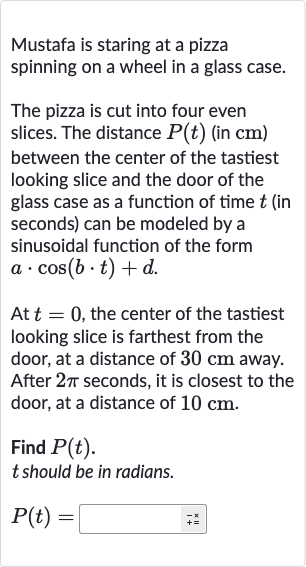AI tutor
Welcome to Bytelearn!
Let’s check out your problem:

Mustafa is staring at a pizza spinning on a wheel in a glass case.The pizza is cut into four even slices. The distance (in ) between the center of the tastiest looking slice and the door of the glass case as a function of time (in seconds) can be modeled by a sinusoidal function of the form .At , the center of the tastiest looking slice is farthest from the door, at a distance of away. After seconds, it is closest to the door, at a distance of .Find . should be in radians.
Full solution
Q. Mustafa is staring at a pizza spinning on a wheel in a glass case.The pizza is cut into four even slices. The distance (in ) between the center of the tastiest looking slice and the door of the glass case as a function of time (in seconds) can be modeled by a sinusoidal function of the form .At , the center of the tastiest looking slice is farthest from the door, at a distance of away. After seconds, it is closest to the door, at a distance of .Find . should be in radians.
- Given Distance Function: We are given that the distance function is a sinusoidal function of the form . At , the distance is at its maximum, which is cm. This means that the vertical shift is cm, and the amplitude is the difference between the maximum and minimum distances.
- Calculate Amplitude: The maximum distance is and the minimum distance is . The amplitude is half the difference between the maximum and minimum distances.Calculation: .
- Calculate Vertical Shift: Now we know that . The vertical shift is the average of the maximum and minimum distances.Calculation: .
- Find Value of b: Next, we need to find the value of , which is related to the period of the function. We are told that after seconds, the slice is closest to the door, which means that the period of the function is seconds.Calculation: The period of a cosine function is given by . Since , we have . Solving for gives us .
- Final Sinusoidal Function: We have now determined all the parameters of the sinusoidal function: , , and . The function is therefore:
More problems from Solve quadratic equations: word problems
QuestionGet tutor help
QuestionGet tutor help
QuestionGet tutor help
QuestionGet tutor help
QuestionGet tutor help
QuestionGet tutor help
QuestionGet tutor help
QuestionGet tutor help
